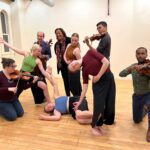
Before they even reached the stage on Saturday night at the Opera House in Boston, the Balé Folclórico da Bahia held the audience in thrall. The lights went down, plunging the ornately gilded theater into darkness, and the sound of ocean waves and birdsong rose accompanied by human voices in a slow, rhythmic chant. As if lit by candles, men and women in white turbans and robes appeared in the center aisles, including a priestly figure in a headdress holding a long staff. They immersed the audience in their mesmerizing voices, before processing onto the stage for a suite of dances entitled “Sacred Heritage.”
The majestic half-hour work, which has its United States premier with this tour, was the first of seven acts in the program, co-presented by Celebrity Series of Boston and World Music/CRASHarts. The company’s repertory draws from the folkloric dances, music and songs of the northern Brazilian state of Bahia, rich in traditions transported from Africa by slaves and mingled with a gumbo of influences, including the cultures of Brazil’s Amerindian natives and Portuguese colonizers.
A distillation of rhythm-driven songs and rites from the Candomblé religion, which transplanted from Africa a pantheon of deities rooted in nature, “Sacred Heritage” was choreographed by Walson Botelho, the troupe’s general director and co-founder, and its artistic director José Carlos Arandiba, in 2008 to honor the 20th anniversary of the Balé Folclórico da Bahia.
What Alvin Ailey’s iconic suite of dances “Revelations” is to the African American Diaspora — a celebration of a people’s journey from slavery to freedom set to spirituals and blues, “Sacred Heritage” is to the African Diaspora in Brazil, which has the second-largest population of African descent in the western hemisphere.
Both works celebrate the transformative artistic and spiritual legacies of a people whose music, dance and faith sustained them and at the same time regenerated the art and culture of their adopted countries.
“Sacred Heritage” brought to the stage 25 performers — 17 dancers, five instrumentalists and three singers.
This taut work of art interwove the rhythmic complexity of the drumming and chanting with the formal simplicity of ensemble dances — lines, circles and whirling shapes accented by the traditional costumes, the women’s enormous hoop skirts and the draping robes of the tall, lean men, who resembled a choir of Ethiopian priests.
Sensuous and solemn at the same time, the repetitive dancing and music subtly varied in pattern and speed, gaining incantatory power. The women in their wide skirts spun like tops while the men did capoeira pinwheels of astonishing fluidity and grace, their hands and feet barely touching the floor.
The human voice too was a spellbinding percussive instrument, particularly the meaty contralto of Dora Santana.
Against the white and beige pageantry of the ensemble, masterfully lit by Marcos Souza, an array of singular, quirky gods made its debut, each a fantastically costumed creature.
The mischievous trickster spirit Exú sprang to life, a nimble satyr in body paint. In a metallic costume, the god of iron and war evoked the Tin Man in “The Wizard of Oz.” Another figure entirely covered in straw suggested the Scarecrow. In a choreographic interplay of order and abandon, the whirling ensemble was a backdrop for solos by the deities, who then exited in a meandering line, as if to follow their own Yellow Brick Road.
Without an intermission, the company continued with six other works, staples from the troupe’s repertoire of Afro-Brazilian musical and dance traditions. Lacking the artistic clarity and power of the “Sacred Heritage” suite, the remaining acts had a choreographic sameness that was enlivened by individual displays of stunstmanship and bravura.
A soloist on the berimbau, a gourd affixed with a long wooden bow, drew from its single string a riff of “The Star-Spangled Banner,” evoking Jimi Hendrix. During a gravity-defying capoeira sequence, men spun across the stage in nonstop cartwheels. In a sensational duo, two men daringly interlocked their fast, high-kicking legs, which moved like buzz saws without ever touching one other’s limbs.
Wearing a tropical panorama of costumes, the ensemble performed in a high-spirited samba circle and in the finale, mingled samba with reggae in an all-out party. The verve, warmth and energy of the singers, dancers and musicians continued undiminished until the curtain fell.

![Banner [Virtual] Art Gallery](https://baystatebanner.com/wp-content/uploads/2024/04/NJ-H_1-150x150.jpg)


![Banner [Virtual] Art Gallery](https://baystatebanner.com/wp-content/uploads/2024/04/NJ-H_1-713x848.jpg)

